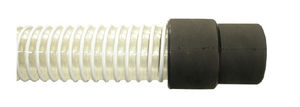
- Hydraulics - Pneumatics
- Pipe, Tube and Fitting
- Foodstuff hose
- Trelleborg Industrial Hose
Foodstuff hose TRELLVAC AL EC for chemical productsfor powdersfor abrasive products



Add to favorites
Compare this product
Characteristics
- Use
- foodstuff, for chemical products, for powders, for abrasive products, for bulk materials
- Material
- rubber, synthetic
- Applications
- transport, for transfer, for chemical applications, FDA, for the food industry, for suction units
- Other characteristics
- wear-resistant, flexible, smooth, lightweight, standard, weather-resistant, ATEX, corrugated, spiral wire
- Inner diameter
Min.: 76 mm
(2.992 in)Max.: 150 mm
(5.906 in)- Outer diameter
Min.: 91 mm
(3.583 in)Max.: 166 mm
(6.535 in)- Pressure
5 bar
(72.519 psi)- Temperature
Min.: -10 °C
(14 °F)Max.: 80 °C
(176 °F)- Delivered length
10 m, 20 m
(32'09" , 65'07" )
Description
Applications:
Extraction and transport hose for bulk abrasive products for the food industry (sugar, grains, flour, milk powder, cattle feed, etc.) and chemicals (PVC, dry stuffs, etc.).
Advantages:
Can be used in ATEX areas: 0, 1, 2 and 20, 21, 22. Non-marking, abrasion resistant cover. Conductive tube and cover considerably extend service life especially for transfer at high speeds.
Overview
Inner tube
foodgrade abrasion resistant NBR, white, smooth
Reinforcement
synthetic textile with embedded steel helix
Cover
wear and weather resistant NBR/PVC, green, corrugated
Electrical properties
conductive tube and cover, R<100MΩ/lg, helix must be connected with couplings.
Standard/Approval
EU regulations No. 1935/2004, 2023/2006. FDA regulation No. 21 CFR 177.2600. French legislation. All relevant migrations tests (France and FDA) were performed by the French institute of Poitiers (IANESCO) and confirmed compliant. Max. vacuum as per ISO 7233.
Catalogs
No catalogs are available for this product.
See all of Trelleborg Industrial Hose‘s catalogsOther Trelleborg Industrial Hose products
Abrasive materials transfer
Related Searches
- Fitting
- Piping
- Hydraulic fitting
- Pneumatic fitting
- Metal fitting
- Polymer hose
- Stainless steel fitting
- Nickel-plated brass fitting
- Structure hose
- Flexible flexible piping
- Elastomer hose
- Abrasion-resistant hose
- Polymer fitting
- Water flexible piping
- Spiral wire hose
- Reinforced hose
- Suction hose
- Smooth piping
- PVC hose
- Smooth hose
*Prices are pre-tax. They exclude delivery charges and customs duties and do not include additional charges for installation or activation options. Prices are indicative only and may vary by country, with changes to the cost of raw materials and exchange rates.





